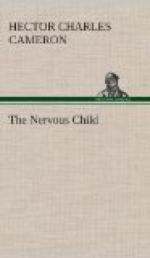(5) HYSTERIA
In hysteria, in contrast to the types previously described, the infective element may be completely absent. Except in some special features of minor importance the symptoms of hysteria do not differ from those of adults, and, as in adult age, the condition of hysteria may be present although the physical development may be perfect. We cannot here speak of any physical characteristics which are associated with the nervous symptoms.
The third or fourth year represents the age limit, below which hysterical symptoms do not appear. Thereafter they may be occasionally met with, with increasing frequency. At first, in the earlier years of childhood, there is no preponderance in the female sex. As puberty approaches, girls suffer more than boys.
It may be said to be characteristic of hysteria in childhood that its symptoms are less complex and varied than in adult life. The naive imagination of the child is content with some single symptom, and is less apt to meet the physician half-way when he looks for the so-called stigmata. Similarly mono-symptomatic hysteria is characteristic of oases occurring in the uneducated or peasant class. In children, hysterical pain, hysterical contractures or palsies, mutism, and aphonia are the most usual symptoms. Hysterical deafness, blindness, and dysphagia are manifestations of great rarity in childhood.
CHAPTER XII
THE NERVOUS CHILD IN SICKNESS
In time of sickness the management of the nervous child becomes very difficult. Restlessness and opposition may reach such a pitch that it may be almost impossible to confine the patient to bed or to carry out the simplest treatment. Sometimes days may elapse before the sick-nurse who is installed to take the place of the child’s usual attendant is able to approach the cot or do any service to the child without provoking a paroxysm of screaming. In such a case any systematic examination is often out of the question, with the result that the diagnosis may be delayed or rendered impossible. There is only one reassuring feature of a situation, which arises only in nurseries in which the management of the children is at fault; the doctor has learned from experience that this pronounced opposition of the child to himself, to the nurse, and even to the mother, is of itself a reassuring sign, indicating, as a rule, that the condition is not one of grave danger or extreme severity. When the child is more seriously ill, opposition almost always disappears, and the child lies before us limp and passive. Only with approaching recovery or convalescence does his spirit return and renewed opposition show itself.




